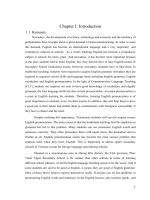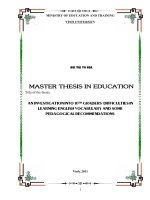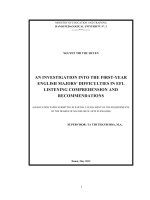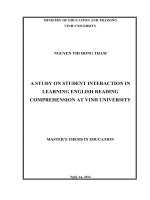An investigation into difficulties in learning English listeing skill at Tan Ky high school
Bạn đang xem bản rút gọn của tài liệu. Xem và tải ngay bản đầy đủ của tài liệu tại đây (714.88 KB, 92 trang )
MINISTRY OF EDUCATION AND TRAINING
VINH UNIVERSITY
NGUYỄN THỊ THUẦN
AN INVESTIGATION INTO DIFFICULTIES IN LEARNING
ENGLISH LISTENING SKILL AT TANKY HIGH SCHOOL
MASTER’S THESIS IN EDUCATION
Nghệ An, 2014STATEMENT OF AUTHORSHIP
I hereby certify that the thesis entitled
AN INVESTIGATION INTO DIFFICULTIES IN LEARNING ENGLISH
LISTENING SKILL AT TAN KY HIGH SCHOOL
i
is the result of my own research for the Degree of Master of Education at Vinh
University. I confirm that this thesis has not been submitted for any other degrees.
Author
Nguyễn Thị Thuần
ABSTRACT
Listening skill is one of the most necessary skills to communicate in the real
life. In learning a foreign language, it is more and more important to learn this skill.
Everybody knows that in order to listen to a message is not as simple as hearing it,
so the listener has to understand the message and responde in the right manner.
Realizing the problems from teaching experiences, the author would like to do a
research titled An investigation into difficulties in learning English listening skill at
ii
Tan Ky high school. The thesis study the subjective and objective difficulties of the
students in learning the listening skill. Then, it would like to find out the reasons for
those problems and the sollutions for both teachers and learners in teaching and
learning the listening skill. Therefore, the author applied the qualitative method and
descriptive method to do the research. So the collecting data instruments like
questionnaires was used to do the study. The results of the research point out the
difficulties that students meet when they learn the listening skill in the Tan Ky high
school. More importantly, it helps the author find out the causes of those difficulties
so that she can work out the right solutions to the problems. With the hope of
improving students’ listening competence, the author has tried her best to do this
thesis on her own experiences and knowledge in English teaching methodology.
ACKNOWLEDGEMENTS
My MA graduation thesis has been completed with a lot of encouragement
and support from my teachers, students, colleagues and family.
I would like to express my deep great thank to my supervisor, Assoc.Prof.
Dr. Ngo Dinh Phuong, for his indispensable and useful advice, suggestions and
support for this thesis. And I wish to thank many teachers for having taught me the
iii
subjects in the MA TESOL course carefully and given me lots of useful advice so
that I could get more background knowledge to complete this thesis.
I also wish to send my sincere thanks to the students of the classes I visited
in order to gather information for my survey questionnaire. Without their help, this
study could not have been successful.
I am indebted to my friends, my classmates, as well as my colleagues for
their invaluable comments and criticism and also for their continued interest and
encouragement.
Finally, I would like to express my gratitude to family members whose
support and encouragement greatly contributed to the completion of my study.
LIST OF ABBREVIATIONS
EFL: English as Foreign Language
FL: foreign language
GE: General English
L1: first language
iv
L2: second language
LIST OF TABLES AND FIGURES
Table 4.1. Students’ attitudes towards English listening. Error: Reference source not
found
Table 4.2. The difficulties in terms of English vocabulary. .Error: Reference source
not found
Table 4.3. The difficulties in terms of grammar....Error: Reference source not found
v
Table 4.4. The difficulties related to lack of background knowledgeError: Reference
source not found
Table 4.5. The difficulties due to lack of listening skills Error: Reference source not
found
Table 4.6. Rank order of difficulties in English listeningError: Reference source not
found
Table 4.7. Students’ views of sources of difficulties.......Error: Reference source not
found
Table 4.8. The students’ needs for English listening materials and equipment Error:
Reference source not found
Table 4.9. The students’ needs for teachers’ methodology . .Error: Reference source
not found
Figure 4.1. Students’ attitudes towards English listeningError: Reference source not
found
Figure 4.2. Causes of difficulties from materials...Error: Reference source not found
Figure 4.3. Causes of difficulties from teachers.....Error: Reference source not found
Figure 4.4. Causes of difficulties from students.....Error: Reference source not found
Figure 4.5. Causes of difficulties from the physical setting. .Error: Reference source
not found
vi
vii
TABLE OF CONTENTS
Chapter 1...................................................................................................................viii
INTRODUCTION.....................................................................................................viii
1.1. Rationale.............................................................................................................viii
1.2..................................................................................................................x
The aim of the study.....................................................................................................x
Research questions......................................................................................................xi
The scope of the study.................................................................................................xi
1.5. The organization of the study...............................................................................xi
Chapter 2...................................................................................................................xiii
THEORETICAL BACKGROUND AND................................................................xiii
LITERATURE REVIEW.........................................................................................xiii
2.2.1. Listening and listening comprehension........................................xvi
2.2.1.1. Definition of listening...............................................................xvi
2.2.1.2. The Importance of Listening Skills..........................................xvii
Types of listening....................................................................................................xviii
a. Real-life Listening........................................................................xviii
b. Classroom Listening........................................................................xx
2.2.4. Overview of the “Tieng Anh 11” Textbook...............................................xxxiii
2.2.4.1. General Description.................................................................................xxxiii
2.2.4.2. Objectives and Approaches to the Textbook Development. .xxxiv
2.2.4.3. Teaching Approaches of the “Tieng Anh 11” Textbook.......xxxiv
4.4.4.1. Suggested Activities for English listening.................................................lxiv
c. Post-listening Stage..........................................................................lxvii
REFERENCES.......................................................................................................lxxiii
Chapter 1
INTRODUCTION
1.1. Rationale
No one can deny the importance of listening skills in foreign language
learning because the key to acquire a language is to receive language input.
Krashen, Terrell, Ehrman, & Herzog (1984) claim that acquisition takes place only
viii
when students absorb enough comprehensible input. The same claim was supported
by Rost (1994) who confirmed that listening is vital in language classrooms because
it provides input for learners. As an input skill, listening plays a crucial role in
students’ languagedevelopment. Krashen (1985) argues that people acquire
language by understanding the linguistic information they hear. Thus language
acquisition is achieved mainly through receiving understandable input and listening
ability is the critical component in achieving understandable language input.
Without understanding inputs at the right level, any kind of learning simply cannot
occur. Thus listening is a fundamental language skill, and as such it merits a critical
priority among the four skill areas for language students. As an English teacher,
with her own knowledge and experience in teaching, the author finds interested in
studying the difficulties in learning the listening skill in English. She would like to
present the thesis “An investigation into difficulties in learning English listening
skills at TanKy high school". She chooses this matter due to the following
reasons.
First of all, listening is the most important skill in communication in the real
life. Listening and speaking are two major parts of communication. They are
closely interdependent. We are only able to talk sensibly when we understand
what is said to us. If we fail to understand spoken language, we may miss
important information and respond in a funny way. Moreover, in learning a
language, listening is a useful means of providing learners with comprehensible
input, which is an essential component of the whole language learning process.
And teaching listening skill in classroom helps learners make transition from
classroom English to real- life English more easily and effectively. Therefore, the
author would like to do this research so as to help teachers and learners pay more
attention to this skill.
Secondly, learning listening skill is the most difficult in learning a foreign
language. Listening, like reading, is a receptive skill but it is often the most
daunting for learners. When reading, a reader usually has more opportunities to
ix
refer back to the text to clarify understanding, which a listener cannot do in most
listening contexts such as TV programs, meetings, discussions, lectures or
conversations. As Harmer said:
Whereas the written word stays on the page and can be looked at more
than once, the spoken word, unless recorded on tape or record cannot be
repeated. Of course in a conversation it is possible to ask someone to say
something again, but the fact remains that while a reader can look back
at something as many times as he wants, the listener cannot.
(Harmer, 1991)
What is more, in teaching and learning English listening skill in Vietnam in
general and in TanKy in particular, teachers and learners cope with a lot of
problems and difficulties because of both objective and subjective reasons. Thus,
the author chooses this topic to point out the main difficulties which the learners
have met and to find the reasons for them.
The last but not least reason for choosing this thesis title is that many
learners are not interested in learning the listening skill. They find listening classes
boring. On the other hand, practicing listening skill is difficult and it takes long
time. It is necessary for teachers to foster the passion for regular listening and to
cater for some learners’ need to listen for relaxation and pleasure. That is the reason
the author would like to work out some suggestions so as to help teachers motivate
their learners to study listening skill more excited and better.
1.2.
The aim of the study
The study is done with the following aims:
Firstly, most students find it difficult to learn listening skill so the author
of the study would like to find the common difficulties that the learners face when
they learn English listening skill at Tan Ky high school.
x
Secondly, the study is carried out in order to survey the real state of
learning English listening skills at Tan Ky high school so that we could work out
the reasons for those difficulties.
Finally, because of the difficulties, many learners are not interested in
learning and practicing this skill at the language class, therefore the study would
like to suggest some possible solutions to those difficulties. They will be very
helpful for the teachers of English at Tan Ky high school, as well as for teachers in
other high schools, to motivate their learners in listening classes. These suggestions
also wish to help the learners catch up with the speed of a normal conversation in
the real life so that they can improve their communication competence.
1.3.
Research questions
The thesis mainly focuses on answering the three following research questions:
1. What are the students’ difficulties in learning English listening at Tan Ky high
school?
2. What are the causes of those difficulties ?
3. What are the possible pedagogical implications that can help to reduce those
difficulties ?
1.4.
The scope of the study
The study is a survey which focuses on the identification of the listening
difficulties that students of Tan Ky high school encountered with according to their
opinions as well as some suggested solutions to help them deal with those problems.
1.5. The organization of the study
The research consists of the following chapters:
Chapter 1: Introduction
This chapter deals with rationale, the aims, the research questions, the scope,
the method and the organization of the study.
xi
Chapter 2: Theoretical background and Literature review
This chapter provide an in-depth review of the previous studies of the issues of
teaching and learning English listening skills. It then presents the nature of
teaching listening such as definitions of listening, the importance of listening
skills, types of listening, factors involved in listening comprehension, Listening
difficulties for students at high schools, causes of difficulties in second language
listening. Additionally, it gives out an overview of the "Tieng Anh 11" textbook.
Chapter 3: Research design and Methodology
This chapter present research approach, subjects, data collection instruments
and research procedures, data analysis and reliability and validity.
Chapter 4: Findings and Discussion
This chapter summarize major findings of the study, suggest some
implications or recommendations for teachers and learners when teaching and
learning listening skills at Tan Ky high school.
Chapter 5: Conclusion
This chapter summarize what have been done in the research, some
limitations of the study and suggestions for further study and suggested further
research.
xii
Chapter 2
THEORETICAL BACKGROUND AND
LITERATURE REVIEW
2.1. Previous studies related to the topic
It can be said that listening is one of the most challenging skills for both EFL
teachers and learners. Therefore, more and more studies of the issues of teaching
and learning this kill have been particularly concerned by a lot of researchers and
educators.
Yagang (1993) pointed out four major factors that made listening difficult to
learners such as the message, the speaker, the listener and the physical setting. He
also suggested some solutions to these problems so that EFL teachers could provide
their students with suitable listening materials, background and linguistic
knowledge, comfortable classroom conditions, enabling skills and useful drills to
encourage them to obtain effective listening strategies.
Olaofe (1994) studied teaching listening comprehension in large classes. He
believed that students could get a lot even under these conditions. In his viewpoint,
it was possible to create an interactive learning environment in large listening
classes. In this case, the only solution is to work in groups in which all the learners
should attempt to do the task individually before getting involved in groupdiscussion. During group reports and presentations, practice in note-taking was
emphasized and the whole class participation enhanced. As a result, the usual
rowdiness accompanying group presentation is considerably reduced.
Jian (2005) paid much attention to teaching listening in a communicative
classroom. She showed the disadvantages of traditional listening teaching and
discovered some communicative ways to teach listening from her experience. In the
traditional classes, teachers act as “a tape-recorder player” and students are “passive
listeners”. In contrast, in the communicative classes, students are given a real
communicative environment with a variety of listening tasks, materials and
xiii
listening strategies so that they can become more active and skillful in listening.
Therefore, the Communicative Language Teaching requires teachers to eradicate
the traditional image of recording players and equip themselves with more
knowledge and skills.
Djiwandono (2006) indicated a technique for teaching listening comprehension that
is a combination of cooperative and stragic learning. Students are required to work
in pairs or in small groups and then cooperate in comprehending the message of a
recorded speech by using listening strategies. This technique helps teachers create a
positive classroom atmosphere as well as promotes interaction among students.
The above foreign studies, to some extent, have significantly contributed to
teaching and learning listening skill.
In Vietnam, this issue has also been received much attention via various
studies by teachers and educators. It proves that teaching listening skills for
Vietnamese learners has become an integral part in the trend of globalization. So
far, there have been many researches related to this field. Le Thi Xuan Anh (2001)
revealed that “Listening Strategies” were unconsciously used by Vietnamese
students at tertiary level. She realized a relationship between the learners’ listening
abilities and their strategy choice. The better listeners seem to employ listening
strategies more often than the worse ones.
Pham Thanh Vinh (2002) investigated the difficulties in listening faced by
first-year students of English at Da Nang College of Education.
The author
discovered four main types of problems that should be taken into careful
consideration such as problems in linguistic features, problems in retrieving
information, problems in catching the main information and problems in notetaking while listening.
Phung Thi Hoai Thu (2008) examined listening difficulties perceived by
teachers and students in using the new English textbook for grade 10 at Que Vo II
upper-secondary school in Bac Ninh. Teachers encountered the obstacles such as
the lack of well-equipped facilities, unfamiliar listening teaching methods,
xiv
inexperience in teaching listening methodology and approaches. Furthermore,
students’ low levels of proficiency in terms of vocabulary, grammar, pronunciation,
skills as well as learning habits were the reasons why students found it difficult and
tough to listen to and they were not confident enough to do listening tasks
successfully. Hence, there was a must to create better suitable teaching methods and
strategies that could facilitate the effectiveness of listening lessons.
Nguyen Thi Kim Ngan (2011) kept on studying the difficulties in teaching
listening comprehension in the course book “Head for Business” to the second-year
students at Economics Department, Hanoi Open University. She pointed out the
challenges that listening teachers often face when teaching the listening
comprehension part of the course book such as the lack of academic training for
teachers, students’ mixed abilities and passive learning habits, poor facility of
teaching and learning, time allocation for listening comprehension as well as
characteristics of the listening comprehension. The research also suggested some
solutions to improve the efficiency of the listening comprehension.
Nguyen Thi Thanh Huyen (2010) suggested using songs as a supplementary
material in teaching listening for the first-year non-major students of English at
Phuong Dong University in Hanoi in order to erase their prejudice against listening
skill, evoke their like and improve the students’ listening state.
Do Van Hoa (2010) proposed that the third-year students at Hong Duc
University in Thanh Hoa province could improve listening skills through portfolio.
The study emphasized the importance of portfolios to the students' self- study in
general and the listening skills in particular. Pedagogically, the findings of the study
were believed to be useful for teachers to be aware of the essential role of portfolios
to the students' self- study in the listening skills.
In summary, it can be seen from the above review that researchers focused on
studying either the general principles for teaching listening skills or the problems
faced by learners in learning listening and suggested solutions to improve their
listening skill. Besides, their research subjects were mainly students at the tertiary
xv
level, not high school students. On the contrary, this study emphasizes the problems
faced by Vietnamese high school teachers in teaching listening and their solutions.
2.2. Theoretical background
2.2.1. Listening and listening comprehension
2.2.1.1. Definition of listening
It is thought that listening plays an important role in the process of acquiring
a language. However, different scholars defined this concept differently.
Listening is theoretically considered as a process in which individuals
concentrate on selected area of aural input, construct meaning from passages, and
relate what they hear to existing knowledge (O’Malley, Chamot and Kupper
(1989)).
Rost (1994) states that listening is a complex process which enables us to
comprehend spoken message.
Anderson and Lynch (1988) define listening as “the means to immediate oral
production, the imitation of spoken forms”. Listeners hear the input as well as
actively process the message to comprehend. The objective of listening
comprehension is that the learners are able to talk and write about what they have
heard after listening. The term “active model builder” is used to refer to the
listeners’ language; they have to build their own “coherent interpretation” of spoken
language. The authors emphasize that the “mental model” which is built as a
representation of a spoken message is the result of our combining the new
information in what we just heard with our previous knowledge and experience.
Buck (2001, p.31) points out that listening is an active process of
constructing meaning by utilizing knowledge to the incoming sound in which both
linguistic and non-linguistic knowledge are involved. He indicates that
“comprehension is affected by a wide range of variables, and that potentially any
characteristic of the speaker, the situation or the listener can affect the
comprehension of the message”.
xvi
In short, it can be said that listening is a language skill involving a wide
range of “sub-skills”. It is more than simply hearing; it is “decoding” sounds and
understanding the meaning behind those sounds.
2.2.1.2. The Importance of Listening Skills
In daily life, people spend much time listening: students listen to their
teachers, children listen to their parents, and adults listen to the news on TV and
radio. Therefore, listening is said to be the most common communicative activity in
daily life: “we can expect to listen twice as much as we speak, four times more than
we read, and five times more than we write” (Morley, 1991: 82).
In language use, the listening skill plays an integral part. It consists of
various types of listener’s knowledge: knowledge of phonology, vocabulary, and
semantics of the language in use, culture of its people, his life experience in the
topic, his ability to predict and respond. It decides his understanding, content and
attitudes towards the speaker’s saying or utterance as well. As a result, we will fail
to communicate with others if we are bad at listening as Mathews, Spratt and
Dangerfield concludes “communication cannot successfully take place unless what
is spoken is also understood” (1991: 61).
What is more, we cannot develop speaking skills unless we also develop
listening skills; to have a successful conversation, students must understand what is
said to them. Later, the ability to understand spoken English may become very
important for listening to the radio, understanding foreign visitors, studying and so
on. In order to develop this ability, students need a lot of practice in listening to
English spoken at a normal speed. That is because students can acquire the language
of “picking up” structures and vocabulary through listening to spoken English. We
should give students as much opportunity to listen to spoken English as possible
because they do not have the language environment outside the classroom.
Harmer (2000) argues that apart from their teacher’s accents and varieties,
the learners should be prepared to hear different ones for the real world listening
xvii
such as telephone conversations, speeches, broadcast news, announcement,
advertisement, etc.
In reality, students’ poor listening ability can cause communication
breakdown. Listening skill, thus, is an indispensable part in EFL learning
environment in Vietnam today. In the current high school curriculum, listening is an
essential language skill that takes up 20% of the lesson’s content in English
textbooks.
In summary, listening provides the aural input that serves as the basis for
second language acquisition and enables learners to interact in spoken
communication.
2.2.1.3.
Types of listening
There are many different types of listening. We can classify these according to
a number of variables, including listening purposes, the role of the listener and the
types of texts being listened to.
a. Real-life Listening
According to some authors, namely Nguyen Thi Van Lam and Ngo Dinh
Phuong (2006), there are two ways of listening in the real life. They are casual
listening and focused listening depending on the purpose of listening.
Many students feel a big gap between listening activities in the classroom and
actual situation. This is because most listening materials including dialogues in
textbooks are very grammar-oriented and controlled in many ways. The speaker
often speaks with perfectly controlled speech, voice, tone, accent and correct
grammar. Whereas, in real-life conversations learners encounter various people
with different gender, age, accent, speed, voice, tone. There may be improper
grammar usage, incomplete sentences, redundancy, contractions, overlap and so
forth.
There are two ways that people often listen in real-life; they are “casual” and
“focus” listening. Many students have a habit of listening to a radio while studying
xviii
or the television is on while we are doing something else. We listen with no
particular purpose. This kind of listening is called “casual” listening, the typical
feature is that we do not listen closely and intentionally, thus we may not remember
much of what we hear or nothing is left in our mind. “Focus” listening happens
when listening for a particular purpose to get the information we need to know or to
study the language. In this case, we often listen with much attention, but we do not
listen to everything with equal concentration. There is an association between
listener expectation and purpose and his comprehension. If the listener expects and
needs are intentional, his listening is likely accurately perceived and understood
than that which is expected, irrelevant or helpful.
In real-life listening, we depend largely on visual information, including
speaker’s facial expression, posture, movement and appearance. When a listener
engages in listening, vocal massage filters through the short-term memory system
first, and at this time, the listener focuses on auditory or visual stimulus and
concentration on the message received. Therefore, visual stimuli play a very
important role in listening.
As for Ur (1992), it would seem reasonable to say that classroom practice
should usually incorporate such characteristics of real-life listening as: We listen for
a purpose and with certain expectations, we make an immediate response to what
we hear, we see the person we are listening to, there are some visual or
environmental clues as to the meaning of what is heard, stretch of heard discourse
come in short chunks, most heard discourse is spontaneous and therefore differs
from formal spoken prose in the amount of redundancy, “noise” and colloquialisms,
and in its auditory characters. Sometimes particular situations may lack one or more
of these characteristics. For example, when watching television we are not normally
expected to respond, when listen to a lecture we may have to hear uninterrupted
speech a very long time indeed, but it is very rare that none of them is present at all.
xix
To sum up, it is obvious that mastering the nature of real-life classroom can
help teachers as well as learners gain success in teaching and learning listening
skill.
b. Classroom Listening
Listening skills that are taught in high schools is almost this type. This is also
the main type of listening that the author is focusing on in this study.
Class-room listening may be divided into intensive listening and extensive
listening. Intensive listening is the careful, focused listening to a short passage for
detailed information or full comprehension, for example, listening to a dialogue on
the tape to study its structures, intonation patterns in an English class. Extensive
listening is freer and more general listening to natural language for general ideas,
not for a particular detail and not necessary under the teacher’s direct guidance. The
listening passage for extensive listening can be long or short. The language that is
used in the type of listening is often within the students’ current ability so that they
find it pleasing and interesting when they are listening. With this type of listening,
students are not reinforcing a structure or practicing a grammar point linked to the
rest of the course.
2.2.1.4. Factors involved in listening comprehension
There are eight characteristics of spoken language which makes listening
difficult (Brown, 2001, p.252).
1. In spoken language, due to memory limitations we break down speech into
smaller groups of words. They are called clustering. For examples ‘a lot of’,
‘a number of’, etc. Therefore when listening, learners have to learn to pick
out manageable clusters of words, avoiding trying to listen to every word of
the speech. It is not necessary and makes learners become distracted.
2. Moreover, spoken language has a great number of redundancies. They are
the result of rephrasing, repetitions, elaborations and some insertions such
as ‘As I have said ‘and so on. At first, learners may get trouble with this.
xx
They are easy to be confused. However, with some training learners can
take advantage of redundancies to have more time and extra information.
3. On the other hand, spoken language also has many reduced forms. It may
be phonological, morphological, syntactic or pragmatic like ‘you’re’
instead of ‘you are’, ‘won’t’ instead of ‘will not’, or ‘can’t’ instead of
‘cannot’. These reductions are really significant difficulties to the learners,
especially beginners when they start getting to know the full form of
English language.
4. The next characteristic of spoken language is performance variables. As a
result of unplanned action, spoken language consists of a lot of hesitations
(‘er’, ‘uhm’), false starts, pauses and corrections. They make the listeners
confused.
5. Colloquial language is another problem that can interfere listeners in real
life listening because they are familiar with standard written language. In
monologues and dialogues, the appearance of idioms, slang, reduced forms
and shared cultural language are common.
6. In listening, learners need to comprehend language delivered at varying
rates of speed and delivered with few pauses because they do not have
opportunity to stop speaker and listen again many times.
7. English is a stress-timed language so it is very important for learners to
understand its prosodic features. By stress, rhythm, and intonation, listeners
can interpret more subtle messages like sarcasm, endearment, insult,
solicitation, praise, etc.
8. The last but not least, interaction is also an element that plays a large role in
listening comprehension. Language learners should be taught the
instruction in the two-way nature of listening. They have to learn to
continue the process of comprehending. Some rules of interaction are
negotiation, clarification, attending signals, turn-taking, topic nomination,
maintenance, and termination.
xxi
In short, it is necessary for language learners to understand all of these
characteristics of spoken language in order that they get more ease in
interaction in general and in listening in particular.
2.2.2. Listening difficulties for students at high schools
2.2.2.1. Linguistics problem
First of all, in phonological aspect, the listeners always get trouble with
sounds. They cannot catch the actual sound of the foreign language since most
listeners rely mostly on context for comprehension. Thus, they are often
themselves unaware of inaccurate sound perception.
Moreover, most learners cannot understand fast, natural native speech.
Normally, in English classrooms, learners usually ask their teacher to speak
clearly and slow down. So they can listen to the words or sounds in isolation.
However, learners have to listen to fast, natural native speech in the real life or in
listening recording.
Vocabulary is also a big problem for listeners. In a listening text, there are
not few new and strange words which make listeners confused. It is often
colloquial such as they use “guy” for “man”, or “kid” for “child”. Since the
learners always try to listen to and understand every word. Therefore they get
more difficult to understand exactly what is said. It is an unconscious result caused
by the teachers or listening materials which encourage the learners to believe that
every word is important. However, the effort to understand everything often
results in ineffective comprehension as well as feelings of fatigue and failure.
Additionally, English grammar is too complicated for students to realize
their meaning when listening. Especially, the students usually have poor
knowledge of grammar. They cannot understand all the natural talk with a lot of
different structures or modality. Informal speech also tends to be somewhat
ungrammatical such as unfinished clauses or sentences are common.
xxii
Finally, the learners’ background knowledge about the world is not
heterogeneous, which causes difficulty in understanding the discourse of the
listening text. It is not easy for the learners to get it correctly.
2.2.2.2. Listening skill problems
There are ten problems that learners often meet
1. The learners are trying to understand every words
Despite the fact that we can cope with missing whole chunks of speech having a
conversation on a noisy street in our own language. So one method of tackling this
is to show them how to identify the important words that they need to listen out for.
In English this is shown in an easy-to-spot way by which words in the sentence are
stressed (spoken louder and longer)
2. The learners get left behind trying to work out what a previous word mean
This often happens when the learners hear a word they half remember and find they
have completely lost the thread of what was being said by the time they remember
what it means.
3. The learners just do not know the most important words
4. The learners do not recognise the words that they know
The students might not recognise a word include not distinguishing between
different sounds in English (e.g. /l/ and /r/ in "led" and "red" for many Asians), or
conversely trying to listen for differences that do not exist, e.g. not knowing words
like "there", "their" and "they're" are homophones. Other reasons are problems with
word stress, sentence stress, and sound changes when words are spoken together in
natural speech such as weak forms. What all this boils down to is that sometimes
pronunciation work is the most important part of listening comprehension skills
building.
5. The learners have problems with different accents
In a modern textbook, students have to not only deal with a variety of
British, American and Australian accents, but might also have Indian or other
English speaking countries thrown in.
xxiii
6. The learners lack listening stamina/ they get tired
This is especially when English is not their first language: listening to
English for several hours causes their brain to reach saturation point and from then
on nothing goes in until they escape to the toilet for 15 minutes.
7. The learners have a mental block
This could be not just a case of a student having struggled with badly graded
listening texts in school, exams or self-study materials, but even of a whole national
myth that people from their country find listening to English difficult.
8. The learners are distracted by background noise
Being able to cope with background noise is another skill that does not easily
transfer from L1 and builds up along with students' listening and general language
skills.
9. The learners can not cope with not having images
Young people nowadays, they just can't cope without multimedia! Although
having students who are not used to listening to the radio in their own language
can't help, most students find not having body language and other cues to help a
particular difficulty in a foreign language.
10. The learners have hearing problems
As well as people such as older students who have general difficulty in
hearing and need to be sat close to the cassette, we might also have students who
have problems hearing particular frequencies or who have particular problems with
background noise.
2.2.2.3. Other difficulties
It is unequal to blame all the problems on the learners and the language
themselves. In fact, there are many factors which affect to learning the listening
skill in a foreign language such as society, language teaching method, and
listening materials, etc.
As it is known that “we cannot teach a language for long without coming face
to face with social context factors which have bearing on language and language
xxiv
learning” (Stern, 1983, p.191). In order to learn a language people first must study
its society and culture to understand the roots of that language. If people learn
English, they have to have definite background knowledge on English speaking
countries. On the other hand, language only can live when people use it. In the
countries, where English is learnt as a foreign language, learning English is
emerging dramatically. However, the results of teaching and learning have not
been heterogeneous because in some places people have not chances to use it
regularly in the real life like in Vietnam.
Another problem is language teaching method. Language teaching has been
defined as “the activities which are intended to bring about language learning”
(Stern, 1983, p.21). And foreign language teaching methodology can be defined as
“the activities, tasks and learning experiences used by the teachers within the
language teaching and learning process” (Richards, 1990, p.35). Teaching method
is necessary to motivate the learners to learn the language. It should be appropriate
for each group of learners, who have different characteristics, and for different
skills. Thus, teaching method should always be appreciated in teaching. In other
words, language teachers with their teaching methods, styles, accents and
intelligence play important roles in instructing their students to learn a new
language item.
Listening materials and learning equipment are also taken for granted in
learning the listening skill. Listening materials are what learners use to listen and
practice listening. They should be interesting and realistic and appropriate with the
learners’ proficiency of English so that it can stimulate their passion in listening.
In order that students are interested in learning the listening skill, it cannot deny
the assistance of the learning equipment. If it is equipped well, it will facilitate
listening and vice-versa if it is poor, the listening activities will be hindered.
2.2.3. Causes of difficulties in L2 listening
2.2.3.1. Low motivation
xxv









